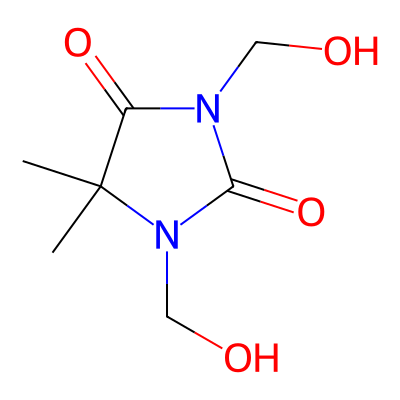
1,3-Dimethylol-5,5-dimethylhydantoin
| Associated High Confidence AOPs |
|---|
Associated AOPs with Level of Relevance 1
| AOP Identifier | AOP Title | AO Classification | OECD Status | Coverage Score | KE Identifier | KE Name |
|---|---|---|---|---|---|---|
| AOP:15 | Alkylation of DNA in male pre-meiotic germ cells leading to heritable mutations | Genetic Disease | WPHA/WNT Endorsed | 0.25 | KE:185 | Increase, Mutations |
| AOP:139 | Alkylation of DNA leading to cancer 1 | Cancer | - | 0.25 | KE:185 | Increase, Mutations |
| AOP:272 | Deposition of energy leading to lung cancer | Cancer | WPHA/WNT Endorsed | 0.29 | KE:1636 | Increase, Chromosomal aberrations |
| KE:185 | Increase, Mutations | |||||
| AOP:303 | Frustrated phagocytosis-induced lung cancer | Cancer | Under Development | 0.14 | KE:1669 | Increased, DNA damage and mutation |
| AOP:409 | Frustrated phagocytosis leads to malignant mesothelioma | Cancer | - | 0.12 | KE:1669 | Increased, DNA damage and mutation |
| AOP:416 | Aryl hydrocarbon receptor activation leading to lung cancer through IL-6 toxicity pathway | Cancer | - | 0.17 | KE:1669 | Increased, DNA damage and mutation |
| AOP:417 | Aryl hydrocarbon receptor activation leading to lung cancer through AHR-ARNT toxicity pathway | Cancer | - | 0.2 | KE:1669 | Increased, DNA damage and mutation |
| AOP:451 | Interaction with lung resident cell membrane components leads to lung cancer | Cancer | - | 0.11 | KE:1669 | Increased, DNA damage and mutation |
| AOP:478 | Deposition of energy leading to occurrence of cataracts | Nervous System Disease; Monogenic Disease | Under Review | 0.2 | KE:1636 | Increase, Chromosomal aberrations |
| KE:185 | Increase, Mutations | |||||
| AOP:534 | Succinate dehydrogenase (SDH) inhibition leads to cancer through oxidative stress | Cancer | - | 0.17 | KE:1553 | Increase mutations |
Associated AOPs with Level of Relevance 2
| AOP Identifier | AOP Title | AO Classification | OECD Status | Coverage Score | KE Identifier | KE Name |
|---|---|---|---|---|---|---|
| AOP:293 | Increased DNA damage leading to increased risk of breast cancer | Genetic Disease; Thoracic Disease; Cancer | Under Development | 0.11 | KE:185 | Increase, Mutations |
| AOP:294 | Increased reactive oxygen and nitrogen species (RONS) leading to increased risk of breast cancer | Genetic Disease; Thoracic Disease; Cancer | Under Development | 0.11 | KE:185 | Increase, Mutations |
| AOP:296 | Oxidative DNA damage leading to chromosomal aberrations and mutations | Genetic Disease; Chromosomal Disease | WPHA/WNT Endorsed | 0.4 | KE:185 | Increase, Mutations |
| KE:1636 | Increase, Chromosomal aberrations | |||||
| AOP:397 | Bulky DNA adducts leading to mutations | Genetic Disease | Under Development | 0.33 | KE:185 | Increase, Mutations |
Associated AOPs with Level of Relevance 3
| AOP Identifier | AOP Title | AO Classification | OECD Status | Coverage Score | KE Identifier | KE Name |
|---|---|---|---|---|---|---|
| AOP:232 | NFE2/Nrf2 repression to steatosis | Gastrointestinal System Disease; Inherited Metabolic Disorder | - | 0.12 | KE:1417 | NFE2/Nrf2 repression |
| AOP:443 | DNA damage and mutations leading to Metastatic Breast Cancer | Thoracic Disease; Cancer | Under Development | 0.3 | KE:1669 | Increased, DNA damage and mutation |
| KE:1554 | Increase Chromosomal Aberrations | |||||
| KE:185 | Increase, Mutations | |||||
| AOP:507 | Nrf2 inhibition leading to vascular disrupting effects via inflammation pathway | Cardiovascular System Disease | - | 0.17 | KE:1417 | NFE2/Nrf2 repression |
| AOP:508 | Nrf2 inhibition leading to vascular disrupting effects through activating HIF1α, Semaphorin 6A, and Dll4-Notch pathway | Cardiovascular System Disease | - | 0.14 | KE:1417 | NFE2/Nrf2 repression |
| AOP:509 | Nrf2 inhibition leading to vascular disrupting effects through activating apoptosis signal pathway and mitochondrial dysfunction | Cardiovascular System Disease | - | 0.14 | KE:1417 | NFE2/Nrf2 repression |
No associated AOPs with Level of Relevance 5
DISCLAIMER
TICToK is a database of tattoo ink chemicals compiled from different regulatory resources. The authors are not liable for any inaccuracies or omissions of any chemicals in this resource. Importantly, our sole goal to build this resource on tattoo ink chemicals is to enable future basic research on this topic, and it does not necessarily reflect the views or objectives of our employers or funders.